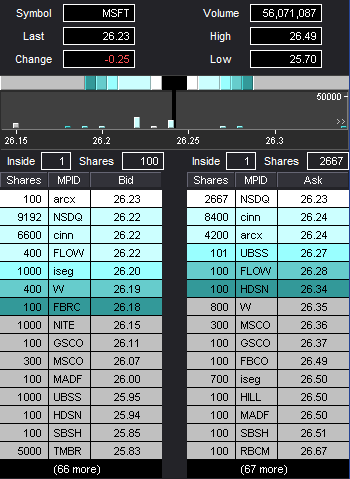Market Makers
A market maker is a broker or a dealer firm that agrees to hold a given number of shares in a particular stock thereby allowing for trading to occur. Market makers compete with each other for sales of a stock to the customer. They do this by quoting sell (ask) prices for a guaranteed number of shares. Upon receiving an order for a stock the market maker is able to fill the order almost immediately from their own inventory.
 To the left you can see a screenshot of a Level II quote. On this screenshot you will see columns with the heading of MPID. These are the initials of the market makers, which are next to the number of shares in their inventory (given in 100’s). This screenshot is of MSFT which trades on the NASDAQ where market makers play a large role.
To the left you can see a screenshot of a Level II quote. On this screenshot you will see columns with the heading of MPID. These are the initials of the market makers, which are next to the number of shares in their inventory (given in 100’s). This screenshot is of MSFT which trades on the NASDAQ where market makers play a large role.
What is the Ax
The “ax” is a market maker who currently has the greatest control over the stock’s trading. They are who daytraders commonly look for on their Level II’s. They are commonly seen supporting the bid and working to increase the bid. They could also be negatively controlling the movement of the stock and selling heavily into the bid, driving the bid and price per share down. The ax may also be working to keep the price trading sideways or near the same price. Keeping the bid and ask very tight.
The ax does not exists at all times, but it is good to be aware of them when they do. They are often heavily controlling the stock you are trading or looking to trade.
Commonly the ax can be found while the S-8 is in the process of completing. You should see an ax jump in and support the bid when the S-8 is close to completion. Then, of course with a strong S-8, this is accompanied with a S-8 Bounce, or strong rise in the price per share.
Finding the Ax
After you have been trading in a stock for a while, you will start to become quite familiar with its Level IIs. It is at that point that you should start to easily notice when that ax is in control and who they are. However, if you are new to a stock, there are a few tricks to finding them.
The Monthly Share Report for a stock will give you a lot of insight into finding the common ax on a stock. When viewing the share report, pay close attention to the top 5 spots (not counting the ECNs). ECNs should be ignored because they can be used by others to buy and sell shares and are usually retail and have little control over the stock.
It is important to note that ax is a slippery one. One MM could be an ax in the morning and another one in the afternoon. An ax can also use an ECN to hide most of their control over the trades.
Spotting the Ax Who is Selling
When the market is moving up nicely and a stock has a lot of new money coming into it, but it is hard even moving up. It seems to be meeting strong resistance at the same MM on the ask over and over. Then, when the stock turns negative, it quite easily falls. This is a strong sign that an ax is controlling things from the ask side. This is very bearish for the stock.